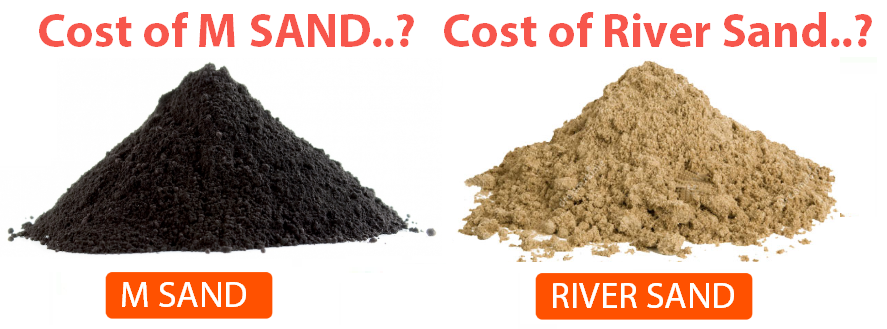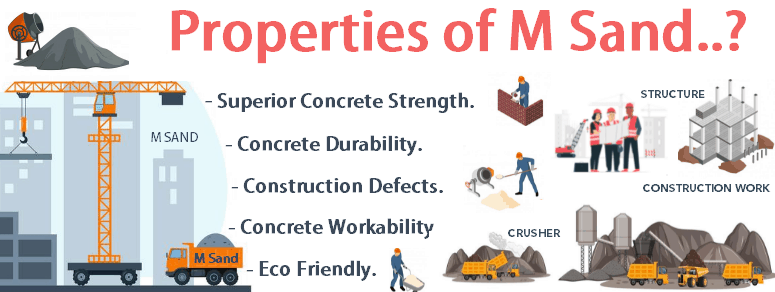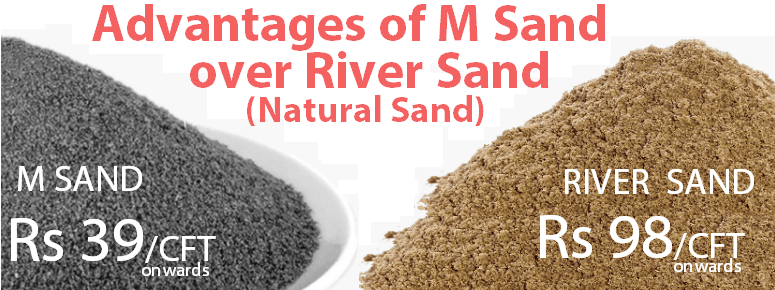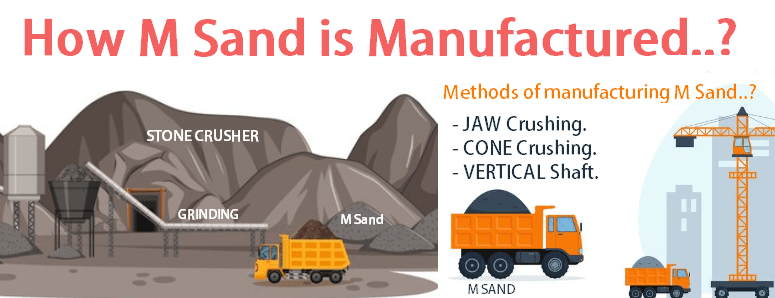What is M Sand?
Manufactured sand, also known as M-sand, is an effective alternative to natural or river sand used in construction and other infrastructure.
Manufactured Sand or M Sand is made by crushing hard natural stones into smaller granules and further washed then graded for multiple uses in construction work.
M Sand is nothing but crushed fine particles of complex stones. Large and rugged rocks are usually washed, ground, and finely graded. The meticulous process of producing M Sand makes it a practical alternative superior to natural sand or river sand that is dominantly used for construction purposes.
Cost of M Sand?
The cost of M Sand (Manufactured Sand) varies from Rs 800 to 1700 per ton. These costs vary depending on the granular particle sizes of M Sand and the type of usage for different Construction works such as Concrete, Plastering, etc.
The cost also varies if the M Sand is water washed to remove micro dust particles, which increases the quality of M Sand.
Cost of River Sand?
The cost of River Sand varies from Rs 2800 to 4500 per ton. These variations depend on the quality of the Sand, How far its sourced from, the Granular size of the sand particles, Silt, and Clay content, etc.
Generally, River sand is twice as expensive when compared to M Sand.
M Sand or River Sand?
If you plan to start your house construction in Bengaluru, you need to consult your Architects or Structural engineers who can guide M Sand and Natural Sand (River sand).
Their expertise will help you choose between M Sand and Natural river sand based on their Properties, Cost, Advantages, Disadvantages, etc.
What are the properties of M Sand?
The following are properties of M sand:
SUPERIOR CONCRETE STRENGTH:
Some of the properties of M Sand (Manufactured Sand) are that once it’s ground into fine particles, it increases the binding strength of the sand. The finely crumbled sand is smooth, perfectly angular shaped.
M Sand has a soft texture that forms a good consistency and increases the binding capability of the sand, which makes it ideal for construction purposes.
These ideal properties of manufactured sand reduce voids, segregation, honeycombing, capillary, and bleeding of the sand, further reducing the chances of construction losing its strength quickly.
These physical properties help in obtaining a better thickness of the concrete. Hence, the perfect consistency of the concrete helps avoid air gaps and fill even the tiniest gaps, which in turn increases the strength of the concrete and that of the Construction.
Info: If you own a residential site and need to know, What would be the possible construction cost in Bangalore? If YES, Then one can use the ” Estimation Calculator ” tool, which is free. This Tool helps you to budget your Dream home based on your requirements.
CONCRETE DURABILITY:
Generally, premium quality granite is used to process the fine particle M Sand. The right balance of both chemical and physical properties of M Sand is ideal for all construction purposes.
M Sand is also known for reducing the permeability and freeze-thaw effect.
The uncompromising binding capability of M Sand allows the concrete structures to resist extreme weather conditions like high-speed winds, cyclones, and heavy rainfall. It also prevents moisture ingress, in turn reducing the corrosivity of reinforcement steel.
Hence, M sand increases construction durability by providing maximum resistance to weather and other adverse conditions.
CONSTRUCTION DEFECTS:
The extreme fineness of the M Sand prevents air gaps, capillarity, honey bleeding, and voids in the concrete. The superior quality binding ability also reduces segregation both during the placement of concrete and after that.
WORKABILITY:
Concrete made with M Sand is very easy to work with. The size, shape of sand particles, and smooth texture play a crucial role in enhancing the workability of the concrete.
The enhanced effectiveness of the concrete due to solid and refined M Sand, therefore, increases the productivity of the construction with minimal effort and cost.
River sand (Natural Sand) usually requires more water and cement to attain proper consistency. But the control over the physical properties of M-sand can reduce the usage of both water and cement, thereby improving the workability.
The amount of water used plays an essential role in bringing better consistency, hence stability and firmness. M-sand allows you to use less water to improve the strength and minimize the effort needed to mix the concrete and placement.
ECO-FRIENDLY:
River sand (Natural Sand) is not a sustainable choice for Construction. It involves scooping more mud out of the river beds, thereby clearing the water beds leading to disastrous environmental impacts in more extended periods.
On the other hand, M sand is eco-friendly, besides providing great resistance and strength to the concrete structures.
Advantages of M Sand?
CUSTOMIZED:
The advantages of M Sand are that it can be customized according to your needs, Construction, texture requirements, and proportion.
No other sand probably has this kind of advantage. In addition, you can choose the proportion and consistency of your sand so that you no longer have to adjust with sub-optimal quality sand for your buildings.
NO IMPURITIES:
M Sand (Manufactured Sand) doesn’t possess other impurities like clay, silt coatings, and dust. The presence of contaminants impacts water requirement, solubility and impair the bonding ability.
M Sand is 100% pure and ideal for concrete structures.
HIGH-QUALITY GRADING:
The latest technology, machinery, and techniques are employed in the production of M Sand (Manufactured Sand). Even the hard rock used is “granite” to obtain the excellent physical properties of the sand.
TECHNOLOGY:
The latest and modernized technologies like High carbon steel hit a rock, and the “Rock on Rock” process is used in M-sand production. These technologies are known to be mimics of natural or river sand making.
Hence, you get top-quality sand for your constructions made from the same natural process without harming the environment.
Advantages of M Sand over River Sand (Natural Sand)?
SHAPE AND TEXTURE:
The shape of M Sand (Manufactured Sand) is generally cubical and angular, making it a better fit for concrete mixing, while the shape of river sand is circular.
While the M Sand has a rough texture, river sand is too smooth a surface.
MOISTURE CONTENT:
M Sand has no moisture content existing in it. In contrast, river sand already has a specific moisture content that may influence the concrete mixing proportions and even the quality of concrete.
On the other hand, with no moisture content, River Sand (Natural sand) leaves room for no confusion regarding concrete mixing, water requirements, and the amount of sand to be used.
ADULTERATION:
M sand (Manufactured Sand) is less susceptible to adulteration than river sand. As river sand is scarce, saline sea sand is mixed with river sand. Such incidences are more prevalent in coastal areas.
However, the same is not the case with River Sand (Natural sand). It can be produced only in required amounts taken from river beds; therefore, there is possible adulteration of Clay, Soil, etc. are known adulterants in River sand.
ECO FRIENDLY:
Sand (Natural sand) leads to Dredging river beds for river sand, depleting groundwater resources and reducing sea levels, adversely impacting the overall environment.
M sand is manufactured and doesn’t involve scooping river beds, making it a sustainable construction.
Disadvantages of M Sand:
COST:
Despite serving its best purpose, M sand (Manufactured Sand) comes with the drawback of consistency in cost. While river sand is 3500/Ton, M sand amounts to 900/ Ton onwards depending on whether it’s double washed, triple washed, finely ground, which suits plastering.
TEXTURE AND SHAPE:
Unlike river sand (natural sand), the shape of M Sand is angular, and the texture is coarser making it require more water to acquire the right consistency.
WORKABILITY:
Even though M sand is soft and smooth, it may contain large amounts of microparticles compared to river sand, which may significantly impact the concrete’s workability and strength.
How is M Sand manufactured?
M Sand is manufactured by multiple techniques and numerous stages to achieve the perfect consistency, texture, and quality.
The factors like raw material used, the process employed, and crushers used greatly influence the output of M sand.
However, the below-mentioned steps are the standard operating procedures employed in the manufacturing of M-Sand:
JAW CRUSHING:
The mined rock fragments from the quarry are first ground to produce variable sizes of smaller rock fragments to ease the further stages of the production process. Then, these giant boulders are sent into the moving jaw plates.
The jaw plates crush the large boulder to create smaller rocks of non-uniform sizes.
CONE CRUSHING:
The second stage also involves the crushing of the stones. In this stage, the rocks that are reduced to smaller sizes are further diminished to even smaller sizes of less than 100mm.
VERTICAL SHAFT IMPACT CRUSHER:
Vertical shaft impact crushers are gaining prominence because of their ability to make fine particles out of coarse stones. The small rocks from the above stage are fed into vertical rotating shafts that rotate with higher RPM (rotations per minute).
This stage 4 stone grinding produces stones with uniform size and soft texture.
SCREENING:
Screening is the fifth stage in the M sand manufacturing process. In this stage, the finely ground sand is screened for quality. The sand is then segregated according to the size of the particles.
CLASSIFICATION:
This is the last step in the production process. Then, according to pre-defined engineering standards, the final M-sand is classified into dry and wet categories and sent to storage for further dispatch.
Where is M Sand used in Construction?
M Sand is used at every stage of Construction as Sand is an inevitable raw material in every construction industry. With the shortage of River sand (Natural Sand) and the overweighing advantages and beneficial properties of M Sand (Manufactured Sand).
M Sand has become a feasible solution to all the prevailing construction-related concerns. The uses of M sand are mentioned below.
RESIDENTIAL CONSTRUCTION:
M Sand (Manufactured Sand) is most commonly used in residential constructions. Most of the residents had already switched to M-sand. Metro cities like Delhi, Chennai, Pune, Bangalore, and Mumbai are already attempting to switch to M-Sand from river sand completely.
CONCRETE MIXING:
M Sand (Manufactured Sand) is primarily used in mixing concrete as it gives the perfect concrete consistency and builds robust constructions.
PLASTERING:
M Sand is the perfect solution for plastering as the sand is crushed into fine particles giving a smooth texture. Plastering with M Sand gives your ceiling and walls an extraordinarily smooth and even finish compared to river sand (natural sand).
RCC REINFORCED CEMENT CONCRETE:
M Sand is an acceptable replacement for river sand in RCC (Reinforced Cement Concrete). Unlike River sand, M Sand has negligible to no impurities, making it an excellent alternative to compensate for the relatively lower flexibility and tensile strength.
EARTHEN EMBANKMENTS:
It’s also a potential and effective replacement in earthen embankments, as it provides better strength for the concrete structures.
BACKFILLING:
M sand can be used in backfilling processes to enhance the strength of the foundation’s structure and improve the support of the building.
The shortage of river sand has prompted an unprecedented surge in demand for M sand. Therefore, M sand(Manufactured sand) is both a complete and partial replacement for river sand.
However, there are certain limitations to its usage in specific cases—the restrictions kick-in in case of the size of sand particles and mica content. Yet, the use can be continued while keeping these factors in check and required proportions.








